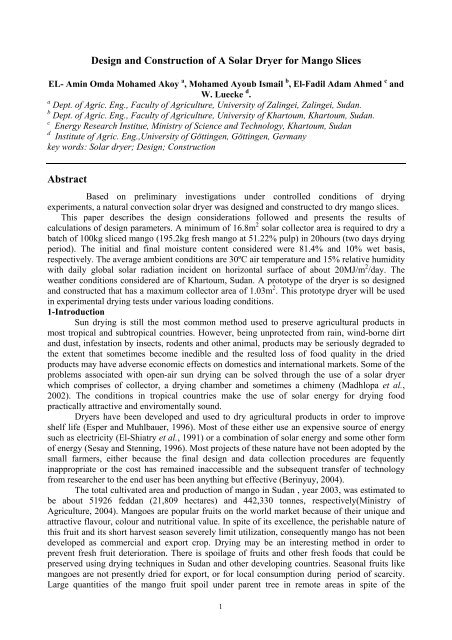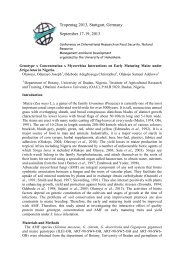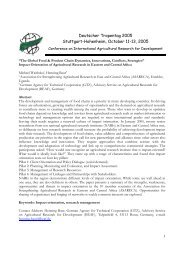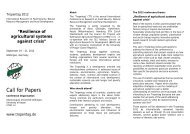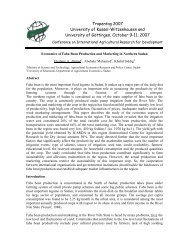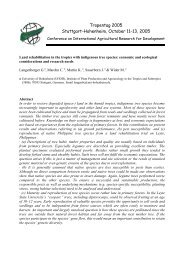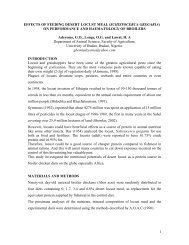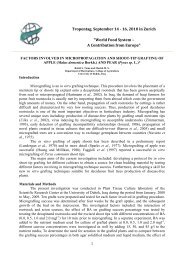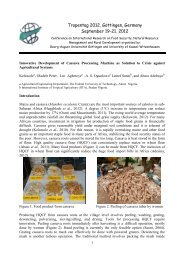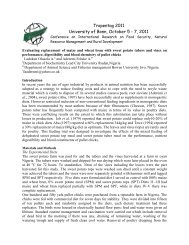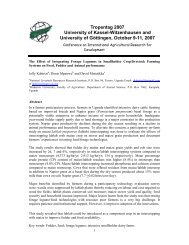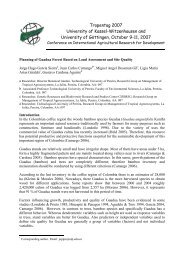Design and Construction of A Solar Dryer for Mango ... - Tropentag
Design and Construction of A Solar Dryer for Mango ... - Tropentag
Design and Construction of A Solar Dryer for Mango ... - Tropentag
You also want an ePaper? Increase the reach of your titles
YUMPU automatically turns print PDFs into web optimized ePapers that Google loves.
<strong>Design</strong> <strong>and</strong> <strong>Construction</strong> <strong>of</strong> A <strong>Solar</strong> <strong>Dryer</strong> <strong>for</strong> <strong>Mango</strong> Slices<br />
EL- Amin Omda Mohamed Akoy a , Mohamed Ayoub Ismail b , El-Fadil Adam Ahmed c <strong>and</strong><br />
W. Luecke d .<br />
a Dept. <strong>of</strong> Agric. Eng., Faculty <strong>of</strong> Agriculture, University <strong>of</strong> Zalingei, Zalingei, Sudan.<br />
b Dept. <strong>of</strong> Agric. Eng., Faculty <strong>of</strong> Agriculture, University <strong>of</strong> Khartoum, Khartoum, Sudan.<br />
c Energy Research Institue, Ministry <strong>of</strong> Science <strong>and</strong> Technology, Khartoum, Sudan<br />
d Institute <strong>of</strong> Agric. Eng.,University <strong>of</strong> Göttingen, Göttingen, Germany<br />
key words: <strong>Solar</strong> dryer; <strong>Design</strong>; <strong>Construction</strong><br />
Abstract<br />
Based on preliminary investigations under controlled conditions <strong>of</strong> drying<br />
experiments, a natural convection solar dryer was designed <strong>and</strong> constructed to dry mango slices.<br />
This paper describes the design considerations followed <strong>and</strong> presents the results <strong>of</strong><br />
calculations <strong>of</strong> design parameters. A minimum <strong>of</strong> 16.8m 2 solar collector area is required to dry a<br />
batch <strong>of</strong> 100kg sliced mango (195.2kg fresh mango at 51.22% pulp) in 20hours (two days drying<br />
period). The initial <strong>and</strong> final moisture content considered were 81.4% <strong>and</strong> 10% wet basis,<br />
respectively. The average ambient conditions are 30ºC air temperature <strong>and</strong> 15% relative humidity<br />
with daily global solar radiation incident on horizontal surface <strong>of</strong> about 20MJ/m 2 /day. The<br />
weather conditions considered are <strong>of</strong> Khartoum, Sudan. A prototype <strong>of</strong> the dryer is so designed<br />
<strong>and</strong> constructed that has a maximum collector area <strong>of</strong> 1.03m 2 . This prototype dryer will be used<br />
in experimental drying tests under various loading conditions.<br />
1-Introduction<br />
Sun drying is still the most common method used to preserve agricultural products in<br />
most tropical <strong>and</strong> subtropical countries. However, being unprotected from rain, wind-borne dirt<br />
<strong>and</strong> dust, infestation by insects, rodents <strong>and</strong> other animal, products may be seriously degraded to<br />
the extent that sometimes become inedible <strong>and</strong> the resulted loss <strong>of</strong> food quality in the dried<br />
products may have adverse economic effects on domestics <strong>and</strong> international markets. Some <strong>of</strong> the<br />
problems associated with open-air sun drying can be solved through the use <strong>of</strong> a solar dryer<br />
which comprises <strong>of</strong> collector, a drying chamber <strong>and</strong> sometimes a chimeny (Madhlopa et al.,<br />
2002). The conditions in tropical countries make the use <strong>of</strong> solar energy <strong>for</strong> drying food<br />
practically attractive <strong>and</strong> enviromentally sound.<br />
<strong>Dryer</strong>s have been developed <strong>and</strong> used to dry agricultural products in order to improve<br />
shelf life (Esper <strong>and</strong> Muhlbauer, 1996). Most <strong>of</strong> these either use an expensive source <strong>of</strong> energy<br />
such as electricity (El-Shiatry et al., 1991) or a combination <strong>of</strong> solar energy <strong>and</strong> some other <strong>for</strong>m<br />
<strong>of</strong> energy (Sesay <strong>and</strong> Stenning, 1996). Most projects <strong>of</strong> these nature have not been adopted by the<br />
small farmers, either because the final design <strong>and</strong> data collection procedures are fequently<br />
inappropriate or the cost has remained inaccessible <strong>and</strong> the subsequent transfer <strong>of</strong> technology<br />
from researcher to the end user has been anything but effective (Berinyuy, 2004).<br />
The total cultivated area <strong>and</strong> production <strong>of</strong> mango in Sudan , year 2003, was estimated to<br />
be about 51926 feddan (21,809 hectares) <strong>and</strong> 442,330 tonnes, respectively(Ministry <strong>of</strong><br />
Agriculture, 2004). <strong>Mango</strong>es are popular fruits on the world market because <strong>of</strong> their unique <strong>and</strong><br />
attractive flavour, colour <strong>and</strong> nutritional value. In spite <strong>of</strong> its excellence, the perishable nature <strong>of</strong><br />
this fruit <strong>and</strong> its short harvest season severely limit utilization, consequently mango has not been<br />
developed as commercial <strong>and</strong> export crop. Drying may be an interesting method in order to<br />
prevent fresh fruit deterioration. There is spoilage <strong>of</strong> fruits <strong>and</strong> other fresh foods that could be<br />
preserved using drying techniques in Sudan <strong>and</strong> other developing countries. Seasonal fruits like<br />
mangoes are not presently dried <strong>for</strong> export, or <strong>for</strong> local consumption during period <strong>of</strong> scarcity.<br />
Large quantities <strong>of</strong> the mango fruit spoil under parent tree in remote areas in spite <strong>of</strong> the<br />
1
enormous potential <strong>for</strong> the utilization <strong>of</strong> solar energy <strong>for</strong> drying <strong>and</strong> other applications. It is ,<br />
there<strong>for</strong>e , envisaged that the design <strong>of</strong> a simple solar dryer could contribute greatly in solving<br />
this problem.<br />
<strong>Solar</strong> dryers are usually classified according to the mode <strong>of</strong> air flow into natural<br />
convection <strong>and</strong> <strong>for</strong>ced convection dryers. Natural convection dryers do not require a fan to pump<br />
the air through the dryer. There<strong>for</strong>e research ef<strong>for</strong>ts will be focused on designing <strong>and</strong><br />
constructing a simple natural convection dryer. Since the rural or remote areas <strong>of</strong> Sudan are not<br />
connected to the national electric grid <strong>and</strong> remote areas <strong>of</strong> Sudan facing energy crisis, especially<br />
West Darfur state. The use <strong>of</strong> solar technology has <strong>of</strong>ten been suggested <strong>for</strong> the dried fruit<br />
industry both to reduce energy costs <strong>and</strong> economically speed up drying which would be<br />
beneficial to final quality (Lambert et al., 1980). El- Shiatry et al. (1991) dried grapes, okra,<br />
tomato <strong>and</strong> onion using solar energy. They concluded that drying time reduced significantly<br />
resulting in a higher product quality in terms <strong>of</strong> colour <strong>and</strong> reconstitution properties. They also<br />
believe that as compared to oil or gas heated dryers, solar drying facilities are economical <strong>for</strong><br />
small holders, especially under favourable meteorological conditions.<br />
The specific objectives <strong>of</strong> this study were:<br />
1- To design a natural convection solar dryer <strong>for</strong> mango slices<br />
2- To construct a prototype <strong>of</strong> the dryer <strong>for</strong> drying mango slices<br />
<strong>Design</strong> Features <strong>of</strong> the <strong>Dryer</strong>:<br />
The solar dryer has the shape <strong>of</strong> a home cabinet with tilted transparent top. The angle <strong>of</strong><br />
the slope <strong>of</strong> the dryer cover is 15º <strong>for</strong> the latitude <strong>of</strong> location (Sodha et al., 1987). The dryer is set<br />
on casters to make it mobile. It is provided with air inlet <strong>and</strong> outlet holes at the front <strong>and</strong> back,<br />
respectively. The outlet vent is at higher level. The vents have sliding covers which control air<br />
inflow <strong>and</strong> outflow.<br />
The movement <strong>of</strong> air through the vents, when the the dryer is placed in the path <strong>of</strong><br />
airflow, brings about a thermosiphon effect which creates an updraft <strong>of</strong> solar heated air laden<br />
with moisture out <strong>of</strong> the drying chamber. The source <strong>of</strong> air is natural flow.<br />
<strong>Solar</strong> <strong>Dryer</strong> <strong>Design</strong> Considerations:<br />
A solar dryer was design based on the produceure described by Ampratwum (1998) <strong>for</strong><br />
drying dates (a cabinet type) <strong>and</strong> procedure described by Basunia <strong>and</strong> Abe (2001) <strong>for</strong> drying<br />
rough rice (natural convection a mixed-mode type). The size <strong>of</strong> the dryer was determined based<br />
on preliminary investigation which was found to be 2.6kg per m 2 (tray loading). The sample<br />
thickness is 3mm as recommended by Bret et al.(1996) <strong>for</strong> solar drying <strong>of</strong> mango slices.<br />
The following points were considered in the design <strong>of</strong> the natural convection solar dryer system:<br />
a- The amount <strong>of</strong> moisture to be removed from a given quantity <strong>of</strong> wet mango.<br />
b- Harvesting period during which the drying is needed.<br />
c- The daily sunshine hours <strong>for</strong> the selection <strong>of</strong> the total drying time.<br />
d- The quantity <strong>of</strong> air needed <strong>for</strong> drying.<br />
e- Daily solar radiation to determine energy received by the dryer per day.<br />
f- Wind speed <strong>for</strong> the calculation <strong>of</strong> air vent dimensions.<br />
<strong>Design</strong> procedure:<br />
The size <strong>of</strong> the dryer was determined as a function <strong>of</strong> the drying area needed per kilogram <strong>of</strong><br />
pulp <strong>of</strong> fruit. The drying temperature was established as a function <strong>of</strong> the maximum limit <strong>of</strong><br />
temperature the fruit might support.<br />
From the climatic data (meteorological station, Shambat, Khartoum North) the mean average day<br />
temperature in April is 30ºC <strong>and</strong> RH is 15 %. From the psychrometeric chart the humidity ratio is<br />
0.0018kg H2O/kg dry air . From the result <strong>of</strong> preliminary experiments on the crop, the optimal<br />
drying temperature was 70ºC <strong>and</strong> final moisture content <strong>of</strong> mango <strong>for</strong> storage is 10% w.b. the<br />
corresponding relative humidity is 51%(sorption isotherms equation).<br />
2
<strong>Design</strong> Calculations:<br />
To carry out design calculations <strong>and</strong> size <strong>of</strong> the dryer , the design conditions applicable to<br />
Khartoum are required. The conditions <strong>and</strong> assumptions summarized in Table 1 are used <strong>for</strong> the<br />
design <strong>of</strong> the mango dryer.<br />
From the conditions, assumptions <strong>and</strong> relationships, the values <strong>of</strong> the design parameters<br />
were calculated. The result <strong>of</strong> calculations are summarized in Table 2.<br />
i- Amount <strong>of</strong> moisture to be removed from a given quantity <strong>of</strong> wet mango slices to bring the<br />
moisture content to a safe storage level in a specified time.<br />
The amount <strong>of</strong> amoisture to be removed from the product, mw, in kg was calculated using the<br />
followig equation:<br />
mw = mp(Mi – Mf) / (100- Mf) (1)<br />
Where: mp is the initial mass <strong>of</strong> product to be dried, kg; Mi is the initial moisature content, % wet<br />
basis <strong>and</strong> Mf is the final moisture content, % wet basis.<br />
ii-Final or equilibrium relative humidity:<br />
Final relative humidity or equilibrium relative humidity was calculated using sorption isotherms<br />
equation <strong>for</strong> mango given by Hern<strong>and</strong>ez et al (2000) as follows:<br />
aw = 1- exp[-exp(0.914+0.5639lnM)] (2)<br />
Where:<br />
aw = water activity, decimal<br />
M = moisture content dry basis, kg water/kg dry solids<br />
aw = ERH/100 (3)<br />
iii-Quantity <strong>of</strong> heat needed to evaporate the H2O:<br />
The quantity <strong>of</strong> heat required to evaporate the H2O would be:<br />
Q = mw x hfg (4)<br />
Where:<br />
Q = The amount <strong>of</strong> energy required <strong>for</strong> the drying process, kJ<br />
mw = mass <strong>of</strong> water, kg<br />
hfg = latent heat <strong>of</strong> evaporation, kJ/kg H2O<br />
The amount needed is a function <strong>of</strong> temperature <strong>and</strong> moisture content <strong>of</strong> the crop. The latent heat<br />
<strong>of</strong> vaporization was calculated using equation given by Youcef-Ali et al. (2001) as follows:<br />
hfg = 4.186*10 3 (597-0.56(Tpr)) (5)<br />
Where: Tpr = product temperature,ºC<br />
Moreover, the total heat energy, E(kJ) required to evaporate water was calculated as follows:<br />
E = m` (hf -hi)td (6)<br />
Where: E = total heat energy, kJ<br />
m` = mass flow rate <strong>of</strong> air, kg/hr<br />
hf <strong>and</strong> hi = final <strong>and</strong> initial enthalpy <strong>of</strong> drying <strong>and</strong> ambient air, respectively, kJ/kg dry air.<br />
td = drying time, hrs<br />
The enthalpy (h) <strong>of</strong> moist air in J/kg dry air at temperature T (ºC) can be approximated as<br />
(Brooker et al., 1992):<br />
h = 1006.9T +w[2512131.0 +1552.4T] (7)<br />
iv- Average drying rate<br />
Average drying rate, mdr, was determined from the mass <strong>of</strong> moisture to be removed by solar heat<br />
<strong>and</strong> drying time by the following equation:<br />
mdr = mw/ td (8)<br />
The mass <strong>of</strong> air needed <strong>for</strong> drying was calculated using equation given by Sodha et al. (1987) as<br />
follows:<br />
m`= mdr / [wf –wi] (9)<br />
Where: mdr = average drying rate, kg/hr<br />
wf –wi , final <strong>and</strong> initial humidity ratio, respectively, kg H2O/kg dry air<br />
3
From the total useful heat energy required to evaporate moisture <strong>and</strong> the net radiation received by<br />
the tilted collector, the solar drying system collector area Ac, in m 2 can be calculated from the<br />
following equation:<br />
AcIη = E = m` (hf -hi)td<br />
There<strong>for</strong>e, area <strong>of</strong> the solar collector is:<br />
(10)<br />
Ac = E/Iη (11)<br />
Where E is th total useful energy received by the drying air, kJ; I is the total global radiation on<br />
the horizontal surface during the drying period., kJ/ m 2 <strong>and</strong> η is the collector efficiency, 30 to<br />
50% (Sodha et al., 1987).<br />
Volumetric airflow rate, Va was obtained by dividing ma by density <strong>of</strong> air which is 1.2 kg/m 3<br />
v-Air vent dimentions:<br />
The air vent was calculated by dividing the volumetric airflow rate by wind speed:<br />
Av = Va/Vw (12)<br />
Where Av is the area <strong>of</strong> the air vent, m 2 , Vw wind speed, m/s.The length <strong>of</strong> air vent , Lv, m, will<br />
be equal to the length <strong>of</strong> the dryer. The width <strong>of</strong> the air vent can be given by:<br />
Bv = Av/Lv (13)<br />
Where Bv is the width <strong>of</strong> air vent, m<br />
vi-Required pressure:<br />
Velocity = Va/A<br />
Va = volumeteric flow rate m 3 /sec.<br />
The pressure difference across the mango slices bed will be solely due to the density difference<br />
between the hot air inside the dryer <strong>and</strong> the ambient air. Air pressure can be determined by<br />
equation given by Jindal <strong>and</strong> Gunasekaran (1982):<br />
P = 0.00308 g(Ti- Tam)H (14)<br />
Where: H is the pressure head (height <strong>of</strong> the hot air column from the base <strong>of</strong> the dryer to the point<br />
<strong>of</strong> air discharge from the dryer), m; P is the air pressure, Pa; g is the acceleration due gravity,<br />
9.81m/s 2 ; Tam is the ambient temperature, C.<br />
The prototype solar dryer was sized to have a minimum area <strong>of</strong> 1m 2 to be used in experimental<br />
drying tests.<br />
Table 1. <strong>Design</strong> conditions <strong>and</strong> assumptions<br />
Items Condition or assumption<br />
Location Khartoum (latitude 15º N)<br />
Crop <strong>Mango</strong><br />
Variety Kitchener<br />
Drying period April to June<br />
Drying per batch ( 2days / batch), 100kg sliced mango (195.2kg fresh<br />
loading rate (mp)<br />
mango)<br />
Initial moisture content (moisture content<br />
at harvest), Mi<br />
81.4 w.b.<br />
Final moisture content (moisture content<br />
<strong>for</strong> storage) , Mf<br />
10 % w.b.<br />
Ambient air temperature, Tam<br />
30ºC (Average <strong>for</strong> April)<br />
Ambinet relative humidity, RHam 15% (Average <strong>for</strong> April)<br />
Maximum allowable temperature, Tmax 70ºC<br />
Drying time(sunshine hours)td<br />
10 hours (Average <strong>for</strong> April)<br />
Incident solar radiation, I 20MJ/m 2 /day (average <strong>for</strong> past 30 years)<br />
Collector efficiency, η 30% (Ampratwum, 1998).<br />
Wind speed 2m/s<br />
Thickness <strong>of</strong> sliced mango 3mm<br />
Vertical distance between two adjacent<br />
trays<br />
15cm<br />
4
Table 2. Values <strong>of</strong> design parameters<br />
parameter value Data or Equation used<br />
Initial humidity ratio, wi 0.0018kgH2O/kg dry air Tam, RHam<br />
Initial enthalpy,hi, 34.5kJ/kg dry air Tam, RHam<br />
Equilibrium relative 51% Mf <strong>and</strong> isotherms equation<br />
humidity, RHf<br />
(2)<br />
Final enthalpy, hf 65.5kJ/kg dry air wi <strong>and</strong> Tf<br />
Final humidity ratio, wf 0.014kgH2O/kg dry air RHf <strong>and</strong> hf<br />
Mass <strong>of</strong> water to be 79.33kg Equation (1)<br />
evaporated, mw<br />
Average drying rate, mdr 3.967kgH2O/hr Equation (8)<br />
Air flow rate, ma<br />
Volumetric airflow rate,<br />
325.1kg dry air/hr<br />
270.94m<br />
Equation (9)<br />
3 /hr ma, air density (ρ)<br />
Va<br />
Total useful energy, E 201.562MJ Equation (6)<br />
<strong>Solar</strong> collector area, Ac 16.8 m 2 Equation (11)<br />
Vent area, Av 0.0376m 2 Va, wind speed<br />
Air pressure, P 0.54Pa Equation (14)<br />
Vent length 11.76m<br />
Vent width 0.032m Equation (13)<br />
<strong>Construction</strong> <strong>of</strong> Prototype <strong>Dryer</strong>:<br />
A natural convection solar dryer <strong>of</strong> a box- type (cabinet) was designed <strong>and</strong> constructed. The<br />
constructed dryer (cabinet-type) consisted <strong>of</strong> drying chamber <strong>and</strong> solar collector combined in<br />
one unit as shown in Fig.1.<br />
50 cm<br />
70 cm<br />
100 cm<br />
5<br />
103cm<br />
76 cm<br />
Fig. 1 Isometric view <strong>of</strong> the constructed solar dryer.
50 cm<br />
Inlet vent<br />
10 cm<br />
Fig.2 Side view <strong>of</strong> the constructed dryer.<br />
103 cm<br />
6<br />
vent<br />
Exit<br />
76 cm<br />
10 cm<br />
13 cm<br />
A simple box frame 103cm long, 100cm wide <strong>and</strong> 76cm high at the back <strong>and</strong> 50 cm high in<br />
front made <strong>of</strong> angle irons (2.54cm x 2.54cm) was fabricated. Sheets <strong>of</strong> mild metal sheet 0.1cm<br />
thick were welded onto three sides <strong>and</strong> bottom <strong>of</strong> the fabricated frame.<br />
Glass wool was used as insulator with a thickness <strong>of</strong> 5 cm <strong>and</strong> placed above the bottom mild<br />
metal sheet. A 98cm x 99cm corrugated galvanized metal sheet was placed above the glass wool<br />
<strong>and</strong> fitted to the bottom <strong>of</strong> the box by nails <strong>and</strong> rivets in addition to wood. The corrugated metal<br />
sheet then painted in black as absorper plate.<br />
Two tray holders made <strong>of</strong> angle iron (2.54cmx2.54cm) were welded in such away to hold<br />
tray inside drying chamber. The lower holder was 15cm above the absorber plate <strong>and</strong> the upper<br />
was 15 cm a part.<br />
Masonite sheets <strong>of</strong> 0.3cm thick were used as insulators <strong>and</strong> fitted to the three inner sides <strong>of</strong><br />
the frame.<br />
Aluminuim foil sheets were glued to masonite <strong>and</strong> used as moisture barrier; prevent moisture<br />
from masonite <strong>and</strong> to reflect incident solar radiations to absorber from sides.<br />
One panel <strong>of</strong> a 4-mm thick transparent glass (102.5cm x 99 cm) was glued to the top part <strong>of</strong><br />
the frame with silicon rubber sealant, which allow the expansion <strong>of</strong> glass at high temperature.<br />
The glass used was low in iron content (water- white glass) because <strong>of</strong> its good transmissivity <strong>for</strong><br />
solar radiation. The glass was inclined at an angle <strong>of</strong> 15 due south , which is the angle <strong>of</strong> the<br />
latitude <strong>of</strong> the experimental site.<br />
In side the drying chamber there were two movable wire mesh trays that can be placed on<br />
their holders. The frame <strong>of</strong> each tray was constructed from wood with dimensions <strong>of</strong> (97cm x<br />
94cm ), while the tray had a surface area <strong>of</strong> (91cmx87.5cm ) <strong>and</strong> 7cm deep, with effective area <strong>of</strong><br />
91cm x 84cm. Each tray was made <strong>of</strong> wood <strong>and</strong> galvanized wire mesh.<br />
For loading <strong>and</strong> unloading <strong>of</strong> material to be dried ,a hinged door was made <strong>for</strong> this purpose.<br />
The hinged door was constructed from galvanized metal sheet (0.1cm thick), 3cm thick cork was<br />
used as insulator. The door was sealed to prevent air leakage between the surroundings <strong>and</strong> the<br />
drying chamber.
Two air vents <strong>for</strong> ventilation were provided. Inlet air hole (front air vent) located above the<br />
base <strong>of</strong> absorber plate; 70cm length <strong>and</strong> 4cm width, provided with adjustable cover that has tow<br />
level <strong>of</strong> opening; full <strong>and</strong> half opening <strong>for</strong> dryer temperature control. The outlet vent (rear air<br />
vent); 100cm x 10cm was located 10cm below the back top edge <strong>and</strong> provided with adjustable<br />
cover <strong>for</strong> dryer temperature control, it has two levels <strong>of</strong> opening; full <strong>and</strong> half opening.<br />
The dryer was set on four casters to make it mobile.<br />
Conclusion:<br />
A solar dryer was designed <strong>and</strong> constructed based on preliminary investigations <strong>of</strong> mango<br />
slices drying under controlled conditions(laboratory dryer).<br />
The constructed dryer to be used to dry mango slices under controlled <strong>and</strong> protected conditions.<br />
The designed dryer with a collector area <strong>of</strong> 16.8m 2 is expected to dry 195.2kg fresh mango<br />
(100kg <strong>of</strong> sliced mango) from 81.4% to 10% wet basis in two days under ambient conditions<br />
during harvsting period from April to June. A prototype <strong>of</strong> the dryer with 1.03m 2 solar collector<br />
area was constructed to be used in experimental drying tests.<br />
References:<br />
Ampratwum,D.B. (1998). <strong>Design</strong> <strong>of</strong> solar dryer <strong>for</strong> dates. AMA, 29(3): 59-62<br />
Basunia, M. A. <strong>and</strong> Abe .T. (2001). <strong>Design</strong> <strong>and</strong> construction <strong>of</strong> a simple three-shelf solar rough<br />
rice dryer. AMA, 32 (3): 54-59<br />
Berinyuy, J. E. (2004). A solar tunnel dryer <strong>for</strong> natural convection drying <strong>of</strong> vegetables <strong>and</strong> other<br />
commodities in Cameroon. AMA, 35(2): 31-35.<br />
Brett, A; Cox, D.R. ; Simmons, R. <strong>and</strong> Anstee,G. (1996). Producing solar dried fruit <strong>and</strong><br />
vegetables <strong>for</strong> micro <strong>and</strong> small-scale rural enterprise development. H<strong>and</strong> book3:<br />
Practical aspect <strong>of</strong> processing. Natural Resources Institute, Chatham, UK.<br />
Brooker, D. B.; Bakker-Arkema, F. W. <strong>and</strong> Hall, C. W. (1992). Drying <strong>and</strong> storage <strong>of</strong> grains <strong>and</strong><br />
oilseeds. Avi, Van Nostr<strong>and</strong> Reinhold. USA.<br />
El-Shiatry, M.A.; Muller, J. <strong>and</strong> Muhlbauer, W. (1991). Drying fruits <strong>and</strong> vegetables with solar<br />
energy in Egypt. AMA, 22(4): 61-64.<br />
Esper, A. <strong>and</strong> Muhlbauer, W. (1996). <strong>Solar</strong> tunnel dryer. Plant Res. And development, 44(4):16-<br />
64.<br />
Hern<strong>and</strong>ez, J. A.; Pavon, G. <strong>and</strong> Garcia, M.A. (2000). Analytical solution <strong>of</strong> mass transfer<br />
equation considering shrinkage <strong>for</strong> modeling food-drying kinetics. Journal <strong>of</strong> food<br />
engineering, 45(1): 1-10.<br />
Jindal, V. K. <strong>and</strong> Gunasekaran, S. (1982). Estimating air flow <strong>and</strong> drying rate due to natural<br />
convection in solar rice dryers. Renewable energy review, 4(2): 1-9.<br />
Lambert, J.M.; Angus, D.E. <strong>and</strong> Reid, P.J. (1980). <strong>Solar</strong> energy applications in agriculture. The<br />
dried vine industry. University <strong>of</strong> Melbourne, Australia.<br />
Madhlopa, A.; Jones, S. A. <strong>and</strong> Kalenga Saka, J. D. (2002). A solar air heater with compositeabsorber<br />
systems <strong>for</strong> food dehydration. Renewable energy, 27:27-37.<br />
Ministry <strong>of</strong> Agriculture <strong>and</strong> Forestry (2004). Department <strong>of</strong> Horticulture. Khartoum, Sudan.<br />
Sesay, K. <strong>and</strong> Stenning, B. C. (1997). A free-convective fruit <strong>and</strong> vegetable hybrid tray dryer <strong>for</strong><br />
developing countries. Cited by Berinyuy, J. E. (2004).<br />
Sodha, M. S.; Bansal, N. K.; Kumar, A.; Bansal, P. K <strong>and</strong> Malik, M. A. (1987). <strong>Solar</strong> crop<br />
drying. Vol. I <strong>and</strong> II. CPR press, Boca Raton, Florida, USA.<br />
Youcef-Ali, S.; Messaoudi, H.; desmons, J. Y.; Abene, A. <strong>and</strong> Le Ray, M. (2001). Determination<br />
<strong>of</strong> the average coefficient <strong>of</strong> internal moisture transfer during the drying <strong>of</strong> a thin bed<br />
<strong>of</strong> potato slices. Journal <strong>of</strong> food engineering, 48(2): 95-101.<br />
7


